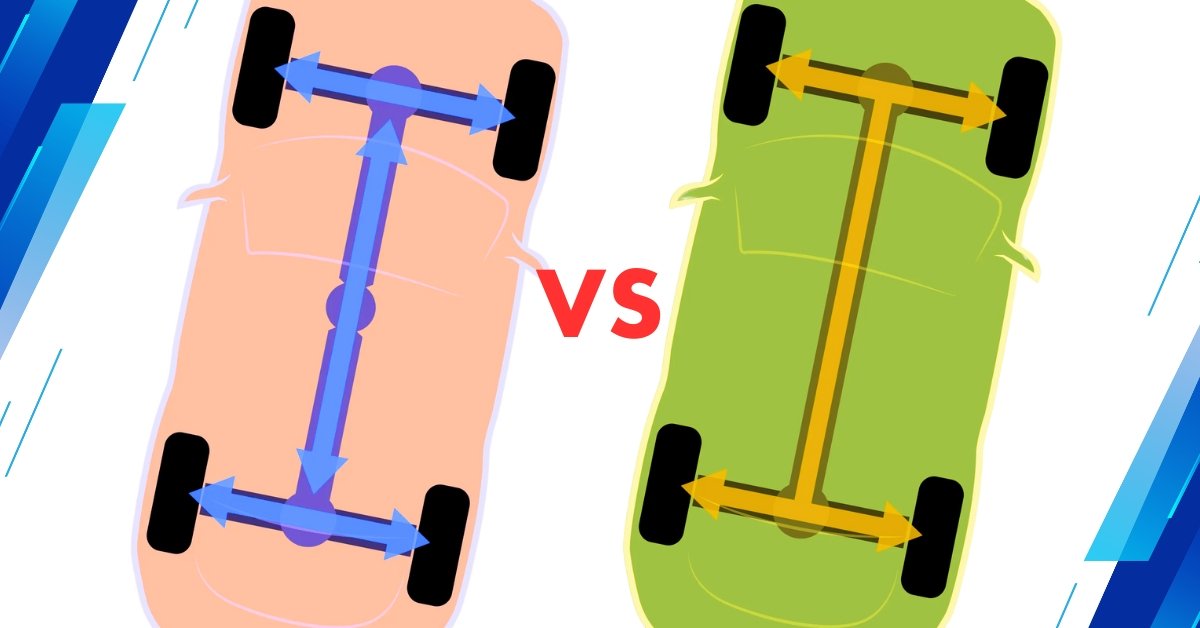When choosing a vehicle, understanding the differences in all wheel drive vs 4 wheel drive is essential. These two systems offer unique advantages, making them suitable for different driving conditions and preferences. In this post, we will explore the fundamental differences between all wheel drive and four wheel drive, compare their performance in various scenarios, and help you decide which option best fits your needs.
Understanding All-Wheel Drive (AWD)
All-Wheel Drive is a system designed to provide power to all four wheels of a vehicle simultaneously. This technology is commonly found in cars, crossovers, and some SUVs. AWD systems are typically automatic, meaning they engage and adjust power distribution based on traction needs without driver intervention. For instance, when a wheel begins to slip, the system automatically sends power to the wheels with better traction.
This capability makes AWD particularly beneficial in varied driving conditions, such as rain, snow, or off-road situations that aren’t too extreme. While AWD is not meant for heavy off-roading, it excels on slick, uneven surfaces, providing enhanced stability and control. Many drivers appreciate the peace of mind that comes with AWD, knowing their vehicle can adapt to changing conditions. Overall, AWD offers a blend of convenience and performance, appealing to a wide range of drivers seeking reliability in diverse environments.
What is Four-Wheel Drive (4WD)?
Four-Wheel Drive is a system primarily designed for off-road driving and is most commonly found in trucks and SUVs. Unlike AWD, which operates automatically, 4WD requires manual engagement, allowing drivers to switch between two-wheel drive (2WD) and four-wheel drive as needed. This feature grants drivers greater control over how the vehicle performs in various conditions.
4WD systems often include low-range gearing, which enhances the vehicle’s capability in challenging terrains, such as rocky paths, steep inclines, or deep snow. By engaging low-range mode, drivers can maximize torque and traction, making it easier to navigate difficult off-road scenarios. This adaptability makes 4WD the preferred choice for those who frequently venture into rugged environments.
However, it’s essential to note that 4WD can be less fuel-efficient than AWD systems. The robust components and added capabilities can lead to increased fuel consumption. Ultimately, 4WD offers unmatched performance for off-road enthusiasts, providing the necessary power and traction to conquer challenging terrains while requiring a bit more involvement from the driver.
Key Differences Between AWD and 4WD
The primary difference between AWD and 4WD lies in their operation and intended use. AWD systems are generally always on and automatically adjust power distribution based on traction needs. This feature makes them well-suited for everyday driving conditions, where roads may be wet or uneven. Drivers can enjoy the benefits of enhanced stability without needing to think about engaging the system.
In contrast, 4WD systems allow for more driver control. Users can manually switch between 2WD and 4WD modes, enabling them to tailor their vehicle’s performance to specific driving conditions. This flexibility is invaluable for off-roading, where the terrain can vary significantly.
Another notable distinction is the presence of low-range gearing in many 4WD systems, which allows for better torque and traction on steep or slippery surfaces. AWD systems typically lack this feature, making them less effective in extreme off-road conditions. Therefore, if you frequently encounter rugged terrains, 4WD might be more suitable. Conversely, for those who prioritize convenience and safety in urban settings, AWD is likely the better choice.
Which is Better, 4WD or AWD?
Determining whether 4WD or AWD is better for you depends largely on your driving habits and the conditions you regularly encounter. For drivers who primarily operate their vehicles on paved roads but occasionally face inclement weather, AWD is often the more advantageous choice. AWD systems automatically distribute power to all four wheels, providing enhanced traction and stability in adverse conditions, such as rain, snow, or gravel roads.
On the other hand, if you frequently engage in off-roading adventures or need to traverse rugged landscapes, 4WD may be the better option. The ability to switch between 2WD and 4WD allows for better control in challenging terrains, while low-range gearing can help conquer steep inclines and deep mud or snow.
Additionally, consider your vehicle’s intended use. If you plan to use it primarily for commuting or city driving, AWD’s convenience and efficiency make it an excellent choice. Conversely, if you envision weekend getaways that involve off-road excursions, 4WD will provide the capability needed to navigate those adventures safely and effectively.
Performance in Snow: AWD vs. 4WD
When it comes to snowy conditions, both AWD and 4WD have their strengths, but they perform differently based on their design. AWD systems are engineered to excel in slippery conditions. The automatic power distribution allows the vehicle to respond to changing traction needs in real time. This feature is particularly beneficial when driving on snowy or icy roads, as it can prevent wheel slip and enhance stability.
In contrast, 4WD can also perform well in snow, especially when equipped with low-range gearing. This feature allows the driver to maximize torque and control, making it easier to navigate through deeper snow or unplowed roads. However, since 4WD typically requires manual engagement, drivers need to be more proactive in switching modes.
Ultimately, the choice may depend on the severity of winter conditions in your area. For urban drivers facing occasional snow, AWD is often sufficient. However, if you frequently travel in areas with heavy snowfall or off-road conditions, a 4WD system may provide the extra traction and control needed for safe navigation.
Advantages of All-Wheel Drive
AWD systems come with several advantages that make them appealing to a wide variety of drivers. One of the most significant benefits is enhanced stability. By distributing power to all four wheels, AWD helps maintain traction and control, particularly in adverse weather conditions. This feature is especially important for families and commuters who want to ensure their safety during inclement weather.
Another advantage is the convenience of automatic operation. Most AWD systems engage without any input from the driver, allowing them to focus on the road ahead rather than worrying about switching modes. This ease of use is a major selling point for many drivers, particularly those who may not have extensive experience driving in challenging conditions.
Fuel efficiency is another area where AWD systems typically outperform 4WD systems. While they may not match the efficiency of 2WD vehicles, AWD options usually provide better mileage than their 4WD counterparts. This makes them an economical choice for daily driving while still offering the added safety and stability that comes with all-wheel drive.
Disadvantages of All-Wheel Drive
While AWD has many advantages, it also comes with some drawbacks that potential buyers should consider. One significant disadvantage is the cost. AWD vehicles can be more expensive than their 2WD counterparts, both in terms of initial purchase price and ongoing maintenance costs. The added complexity of AWD systems may lead to higher repair bills if something goes wrong.
Another downside is that AWD systems generally do not perform as well as 4WD in extreme off-road situations. If you frequently engage in serious off-roading, an AWD system may not meet your needs. The lack of low-range gearing limits its capabilities in challenging terrains, making 4WD a more suitable choice for adventurous drivers.
Moreover, some drivers may notice increased tire wear in AWD vehicles. Since power is sent to all wheels, tires can wear unevenly, especially if they are not rotated regularly. This aspect can lead to higher long-term costs, as tires may need to be replaced more frequently than in a 2WD vehicle.
Why AWD Might Be the Best Choice for You
If you prioritize safety, convenience, and comfort in your everyday driving, AWD could be the best choice for you. The automatic power distribution to all four wheels provides enhanced traction in various conditions, giving you the confidence to tackle slick roads and unpredictable weather. Many drivers appreciate the reliability of AWD, especially in regions that experience harsh winters.
Additionally, AWD vehicles are often more versatile than traditional 2WD options. They can handle a range of conditions, from wet pavement to light off-roading, without requiring driver input. This makes them ideal for those who want a vehicle that can adapt to different scenarios seamlessly.
For urban drivers who encounter rain and snow but do not need extreme off-road capabilities, AWD is often the ideal compromise. It combines the convenience of automatic engagement with the added safety benefits of enhanced traction. Ultimately, choosing AWD can provide peace of mind, knowing you have a vehicle ready to perform in various environments.
Conclusion
In conclusion, understanding the differences between All-Wheel Drive and Four-Wheel Drive is crucial for making an informed vehicle choice. Each system has its unique strengths and weaknesses, tailored to different driving needs. AWD is best for those who primarily drive on paved roads and encounter occasional inclement weather, providing convenience and enhanced stability. Conversely, 4WD is suited for off-road enthusiasts seeking robust performance in challenging terrains.
Ultimately, your choice should reflect your driving habits and the environments you regularly navigate. By considering factors like weather conditions and terrain, you can select a vehicle that aligns with your lifestyle, ensuring a safe and enjoyable driving experience.
FAQs about AWD and 4WD
What is the main advantage of AWD?
The primary advantage of AWD is its automatic power distribution to all four wheels, providing enhanced traction and stability in various driving conditions.
Can you switch from 4WD to 2WD?
Yes, most 4WD systems allow drivers to switch between 2WD and 4WD, depending on the driving conditions.
Is AWD better for city driving?
AWD is generally better for city driving as it offers improved stability and traction in rain and light snow without the need for driver intervention.
How does AWD affect fuel efficiency?
AWD systems can be less fuel-efficient than 2WD systems, but they often offer better fuel efficiency than 4WD systems, especially in everyday driving conditions.
What are the best vehicles with AWD?
Many manufacturers offer vehicles with AWD, including popular options like the Subaru Outback, Audi Q5, and Honda CR-V. Each offers unique features catering to different driving needs.










